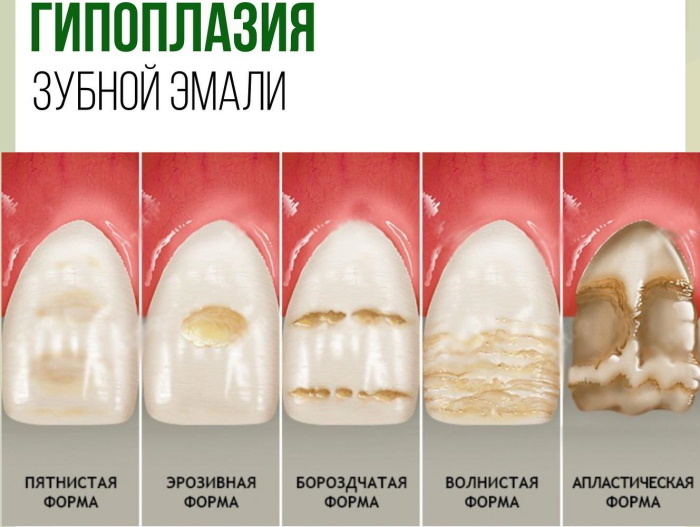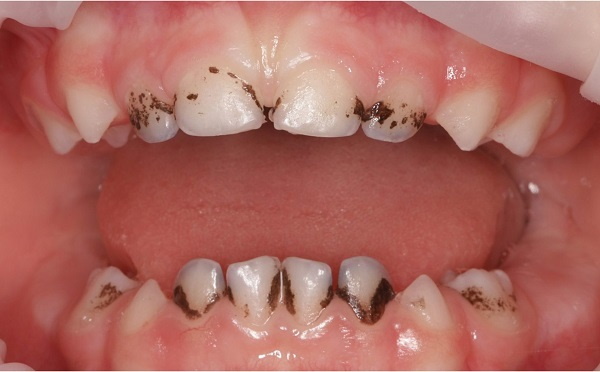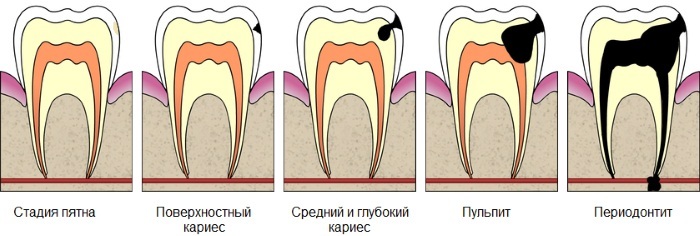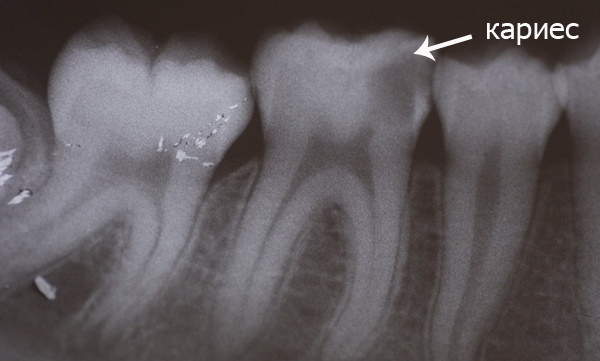Content
- Why do black streaks appear on the teeth of children?
- Priestley's raid
- Black streaks on chewing teeth from caries
- How to detect dark plaque in time
- How is the cause of the appearance of black bars determined?
- Why remove Priestley's plaque?
- Treatment methods
- Protection measures against the appearance and spread of black stripes
- Possible complications
- Treatment cost
- Video about black stripes on teeth
Changes in the natural shade of tooth enamel provoke pathological processes, infectious factors, a violation of the microbial balance of the dental space. Black streaks are often a symptom of tooth decay.. The color of the teeth is influenced by diet, taking tetracycline antibiotics, mineral and trace element deficiency.
Why do black streaks appear on the teeth of children?
Discoloration of the jaw rows gives the oral cavity an unaesthetic appearance, causes bad breath, and is difficult to remove without dental assistance.
Common causes of darkening of teeth in children:
- Dysbacteriosis. Digestive dysfunctions or gastroenterological diseases at an early age are due to unbalanced diet with an emphasis on confectionery, intoxication, not fully formed the gastrointestinal tract.
- Dehydration. Due to pathological dehydration, the salivary glands do not produce enough secretion to clean the jaw elements and break down food. The deposits gradually form black stripes, creating a breeding ground for the development of fungal and bacterial infections.
-
Enamel hypoplasia. Underdevelopment of the protective-surface coating occurs for genetic reasons or due to intrauterine disorders. Longitudinal grooves appear on the teeth, which fill in food debris, microbial waste products, and other particles. Oxidation when interacting with atmospheric oxygen gives the deposits a black tint.

- Immune disorders. Such pathologies impair the body's ability to resist the penetration of pathogenic microflora, intensive reproduction of opportunistic microorganisms in the oral cavity.
- Deformation of the bite. The violation leads to an uneven distribution of the chewing load. The teeth with the best functionality are cleared by saliva, solid foods - apples, carrots, and others. Jaw elements with a low chewing load are covered with a film coating over time.
Black stripes on teeth in children are formed with poor absorption of calcium and a deficiency of fluoride - these are the main structural substances of bone tissue and enamel. Dentists consider neglect of the rules of oral hygiene as a common cause of discoloration of the jaw apparatus.
Among the pathogenetic factors of childhood, metabolic and metabolic disorders are distinguished. Such causes of dental discoloration are a symptom of systemic diseases. Mechanical damage, thermal or chemical injuries lead to a change in the shade of the jaw rows.
Priestley's raid
Pigmentation mainly affects milk teeth. The dark plaque is bacterial in nature. Deposits run as a black or dark brown border near the gum tissue that forms the dental bed. Priestley's raid, depending on the degree of damage, covers a large area or looks like a thin stripe.
The products of microbial activity are localized on the inner surface of the elements of the jaw row, in the interdental clefts, on the outer plane. Priestley's plaque by itself does not destroy enamel, does not lead to dental or gastroenterological diseases.

Its formation may indicate a decrease in local immunity, which is fraught with the addition of a more aggressive pathogenic microflora. Priestley's plaque affects young children and almost never settles on permanent teeth. The phenomenon is considered purely as a temporary aesthetic defect.
Black streaks on chewing teeth from caries
A common dental disease is characterized by the formation of areas of dark pigmentation on the functional elements of the jaw rows. The defeat is accompanied by pain.
Due to the destruction of the enamel coating, teeth react sharply to temperature and other influences:
- hot food;
- cold air;
- cold drinks;
- ice cream;
- sweets.
Caries damages dentin, creates favorable conditions for the attachment of pathogenic microorganisms. The chewing molars are the first to be destroyed due to their active participation in the process of grinding food.
The reasons for the development of pathology:
- non-observance of the rules of oral hygiene;
- the use of detergents or bleaching agents that damage the enamel coating;
- release of aggressive acidic compounds by particles of biological origin;
- unbalanced diet or malnutrition;
- disorganization of the dental structure due to vitamin and mineral deficiency;
- exposure to exogenous factors;
- hereditary predisposition.
 Black stripes are formed on dental tissues, mucous membranes, gingival surfaces. Caries is not considered an independent nosological unit. Dark pigmentation occurs due to a complex of pathogenetic causes of a systemic and local nature.
Black stripes are formed on dental tissues, mucous membranes, gingival surfaces. Caries is not considered an independent nosological unit. Dark pigmentation occurs due to a complex of pathogenetic causes of a systemic and local nature.
There are over 400 theories of caries development. Black stripes are a noticeable symptom of a pathological process that destroys dental tissue. Dark plaque of carious origin has a dense structure and does not lend itself to self-removal at home.
Deeply embedded in hard dentin tissue, firmly binding to the internal dental structure, the deposits become a favorable environment for the reproduction of pathogenic microorganisms.
Black stripes on the teeth with the development of caries quickly expand the affected area. A significant proportion of the microbial flora living in them falls on streptococcal infection, which can colonize the respiratory tract, genitourinary system, and gastrointestinal tract.
The bacteria secrete lactic acid, which corrodes tooth enamel and demineralizes dentin. The leading role in the destructive process belongs to the polysaccharide dextran, produced by streptococcal microorganisms.
Black stripes of carious genesis are associated with the consumption of foods saturated with fast carbohydrates. The degree of activity of pathogenic bacteria in the oral cavity and dental plaques depends on individual physiological characteristics, the state of the immune status.
With a reduced resistance of the organism, black stripes quickly increase the coverage area of the jaw rows. It is impossible to eliminate them without dental intervention.
The risk of accompanied by dark pigmentation and severe pain syndrome of caries on the chewing teeth increases with a change in the mineral composition of salivary fluid, which reduces its antibacterial properties.
How to detect dark plaque in time
Deposits are visually visible on examination of the oral cavity. Regular scheduled preventive visits to the dental office are recommended. Priestley's plaque builds up slowly in children.
Carious deposits progress quickly, accompanied by painful symptoms. Such pathological changes are easier to detect. Dark stripes have a distinctive appearance.
The reactive development of dental disease is accompanied by intoxication signs, drying out the mucous membrane of the dental space, increased body temperature during periods of severe exacerbation.
There is no difficulty in detecting such a process. Most often, due to pathological reasons, black pigmentation of the teeth in children appears at the age of 2-3 years, when the child cannot clearly formulate his condition.
It is important for parents to exercise care for the timely detection of destructive changes and prevention of further destruction of the jaw rows. The launched process is capable of spreading to permanent teeth.
How is the cause of the appearance of black bars determined?
In dental practice, a relatively small number of methods for diagnosing discoloration of the elements of the jaw apparatus are used. A dental examination is often sufficient.
The doctor determines the carious cause of the appearance of black stripes by characteristic signs. If necessary, appoint additional instrumental studies.
Applied methods of hardware diagnostics are shown in the table:
| Survey method | Characteristics |
| X-ray | This method of visualization of the jaw structure is used for the anatomical and functional assessment of the internal structure of the teeth, to identify deviations and the degree of pathological changes. |
| CT scan | Modern research distinguishes safety in terms of patient exposure. CT is an informative imaging technique that allows you to obtain a clear three-dimensional image of the jaw apparatus. Computed tomography is used for primary instrumental diagnostics, assessment of the dynamics of pathology and the effectiveness of the treatment. |
| Microscopy | Increases the studied areas of the oral cavity 25-30 times. Microscopic examination allows you to study the structural structure of the enamel coating, to establish the nature and extent of the pathological lesion. |
| Rheodentography | It is used to assess the parameters of hemodynamics, the functional state of the pulp, to determine the stage of carious lesions. Rheodentography is used to study the tonic tension of the vascular walls, vasoconstriction and vasodilation. |
Black stripes have various etiological factors. On the teeth, such deposits are formed for hygienic, bacterial, and carious reasons. To clarify the diagnosis, an electro-dental examination is prescribed.
The technique is based on the supply of a calculated current of strength and voltage to the nerve fibers of the elements of the jaw rows to determine the excitation threshold of pain, temperature, tactile receptors.
Superficial caries needs precise differentiation in order to apply adequate therapeutic tactics. The pathogenetic characteristics of the disease resemble enamel hypoplasia, fluorosis, wedge-shaped defect in dental tissues.
These disorders require treatment other than caries. It is often sufficient to determine the localization and appearance of pigmentation during the initial physical examination. To clarify the diagnosis and the depth of morphological changes, additional instrumental studies are prescribed.
Why remove Priestley's plaque?
Dark deposits on the jaw rows do not form in all children. The appearance of black pigmentation is due to reactions to changes in dietary patterns and environmental factors, the state of the immune system.
Priestley plaque is removed for aesthetic and cosmetic reasons. Containing food rotting products, all kinds of organic particles of sediment become a favorable environment for the multiplication of bacteria, the development of mycotic flora.
This could theoretically lead to infection of internal organs. Most often, pathogenic microorganisms affect the respiratory system, gastrointestinal tract, urogenital apparatus.
Priestley's plaque can mask the onset of a carious process. It is recommended that such deposits be removed in the dentist's office using professional methods that do not damage the dental tissue.
Another reason for cleaning is bad breath, which exude rotting products and substances secreted by microbes. The procedure causes some discomfort. Removal of superficial black streaks is carried out in one session.
Treatment methods
Before grinding the teeth to restore their natural shade, the oral cavity is sanitized. It is necessary to cure all elements of the jaw rows. Professional hygiene of the dental space involves the use of ultrasonic or laser exposure.
Black streaks on the teeth are removed with specialized dental brushes. Deeply embedded deposits are cleaned off with a drill with an installed grinding head. They use medicinal compositions of a pasty consistency with a high content of calcium-fluoride compounds.
Priestley's plaque in children is removed by a simple cleaning method, which is effective for superficial deposits without pathological changes in the morphological structure of dentin tissues.
Special bleaching solutions are used. They are applied to the enamel coating, installed in the dental canals. For adults, restoration procedures are used, which involve hiding the defect with decorative crowns or veneers.
Ceramic or porcelain onlays replace the damaged enamel coating.
Such decorative elements:
- allow you to give your teeth any shade;
- protect from the destructive effects of external factors;
- correct the violation of the geometric shape;
- increase mechanical strength;
- increase resistance to bacterial and fungal microflora.
The therapeutic technique is selected based on the diagnostic results, taking into account the cause of the pigmentation. Surface deposits can be removed at home with bleaching pastes and gels.
Pigmentation provoked by systemic pathologies or dental diseases is eliminated by complex treatment. With dysfunctions of the thyroid gland, causing the formation of black plaque on the teeth, vitamin and mineral preparations, medicines containing fluoride and calcium are prescribed.
Treatment for pigmentation varies between children and adults. Orthopedic structures, laser or mechanical resurfacing procedures are not suitable for babies due to the peculiarities of growth, the structure of milk teeth, and their low strength.
Bacterial plaque is removed after preliminary disinfection of the dental space with an antiseptic solution. The dental surface is treated with the Air Flow apparatus, which injects the therapeutic mixture under pressure.
To polish the enamel coating in adults, a special strip is used - a thin metal or polymer plate. With a pronounced inflammatory process of the mucous membrane, antibacterial applications, healing ointment compositions are used.
Protection measures against the appearance and spread of black stripes
To exclude systemic factors of the formation of dark deposits, laboratory tests are carried out, which can identify infectious and parasitic agents. With regular preventive examinations, Priestley's surface plaque is detected at an early stage.
It is recommended to perform dental hygienic treatment every 6 months. Otherwise, the consistency of the plaque becomes denser, and a carious lesion develops. To protect the oral cavity, preventive debridement with chlorhexidine is performed.
Black streaks on teeth are often caused by an increased intake of fast carbohydrates. Diet correction is used to protect against dark deposits. It is recommended to periodically monitor the microbiological composition of salivary secretions using laboratory methods.
The main home remedy for preventing the appearance and spread of dark streaks is a toothbrush. The hygiene item is selected individually in accordance with the anatomical structure of the jaw apparatus.
Another protective agent is toothpaste.
Such compositions are distinguished by:
- antibacterial properties;
- pleasant taste;
- inability to damage enamel;
- the presence in the composition of pyrophosphate, zinc chloride, potassium nitrate.
Hygiene products stabilize the mineral-alkaline balance in the oral cavity, destroy the supragingival calculus, and reduce the susceptibility of teeth to destructive external influences.
To protect the jaw apparatus from the formation of black plaque, pastes saturated with calcium carbonate are used. Such products neutralize acidic compounds that destroy enamel.
Dentists recommend changing the toothbrush every 1.5-3 months. To clean the interdental gaps from organic deposits that quickly colonize bacteria, special floss threads are used.
Possible complications
Chronic black plaque causes inflammation of the epithelial tissues. The gingival tissue swells, which leads to the formation of false pockets, the release of pathological exudate. Such a liquid serves as a breeding ground for pathogenic microorganisms.
Among the severe complications of black stripes, there are:
- bacterial caries - softening of dentin by acidic substances secreted by disease-causing agents;
- gingivitis - inflammation of the gum tissue, accompanied by local hyperemia, bleeding, swelling;
- periodontitis - atrophy of the fibers that hold the dental element in the natural anatomical bed;
- stomatitis is an erosive and ulcerative disease of the dental space, the severe form of which causes necrotization of the affected areas;
- halitosis - bad breath, provoked by the multiplication of microbial flora in periodontal pockets;
- infectious endocarditis - damage to the valve parts of the heart apparatus by pathogenic pathogens penetrating from the gingival pockets.
Black stripes lead to anatomical deformities with malocclusion, distortion of the facial oval. Dental diseases provoked by dark deposits cause painful reactions that bring severe discomfort.
Treatment cost
The price of procedures in a commercial dental office is determined individually. The final cost of treatment depends on the cause of the dark deposits, the presence of complications, and the cleaning technology used.
The patient pays separately:
- expendable materials;
- diagnostic measures;
- use of dental equipment, ultrasound or laser equipment;
- consultation of narrow specialists;
- decorative overlays, if they are supposed to be installed.
The cost of eliminating black streaks varies widely. It also depends on the pricing policy of the dental clinic. On average, a full package of services for the removal of dark plaque on teeth in the capital and St. Petersburg costs 5,000-6,000 rubles.
Video about black stripes on teeth
Children's dentistry. Priestley's raid:


